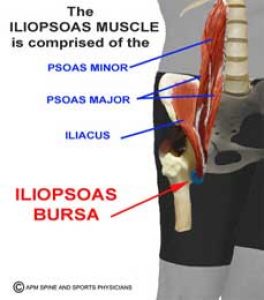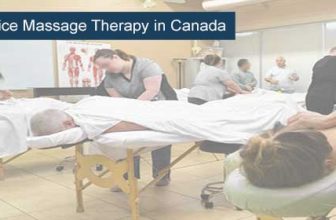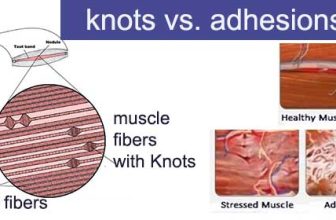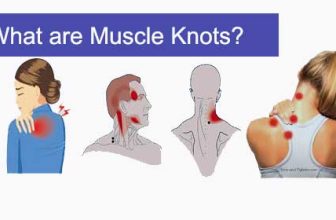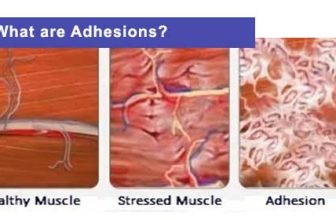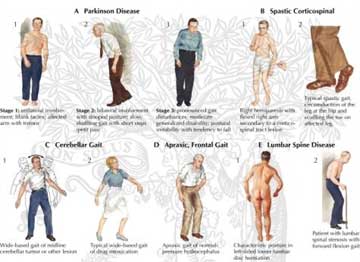
Gait is the pattern of how a person walks. Different types of gait/ walking problems occur without a person’s control. Most, but not all, are due to a physical condition.
For The Components of The Gait Cycle and Gait Assessment, see : Gait Assessment page
Abnormal Gaits / Problems with Walking:
1. Antalgic Gait
- An antalgic gait is a gait that develops as a way to avoid pain while walking (antalgic = anti- + alge, “against pain”).
- painful (antalgic) gait may occur if patient is protecting an injury to the foot, ankle, knee hips or pelvis
- usually the STANCE phase on the affected leg is shorter in duration because the patient attempts to remove affected leg from weight bearing – therefore- note and compare stance phase of the two legs
- decreased walking velocity = decreased steps per minute (normal is 90-120 steps/minute)
- observe if the hand is supporting the painful area
Abnormal Gaits: Antalgic Gait Video
2. Ataxic Gait
- Abnormal gait due to poor sensation or lack of muscle coordination
- Ataxia is a neurological sign consisting of lack of voluntary coordination of muscle movements that includes gait abnormality. Ataxia is a non-specific clinical manifestation implying dysfunction of the parts of the nervous system that coordinate movement, such as the cerebellum.
- may be due to drinking alcohol
- patient’s gait / walk lacks balance, may appear irregular, jerky, weaving and staggering
Abnormal Gaits: Ataxic Gait Video
3. Arthrogenic Gait
- stiff hip or knee or ankle due to stiffness, laxity or deformity
- joint related pathologies (examples of joint pathologies are osteoarthritis, hip joint problems such as avascular necrosis of the femoral head, rheumatoid arthritis, etc…)
- pelvis may be elevated on the affected side to provide for toe clearance especially if the hip or knee is fused
- see if the patient lifts the entire leg so they could clear the ground (may be similar to Gillet’s – SI joint involvement)
- compare gait length ( how far they are stepping)
Abnormal Gaits: Arthrogenic Gait Video
4. Trendelenburg’s Gait
- This abnormal gait is due to gluteus medius weakness or paralysis.
- trendelenburg’s sign ( hip popping out on the weight bearing side) may be seen
5. Lurching Gait
- due to paralysis or weakness of the gluteus maximus
- hand drops down, thorax moves posteriorly on the affected arm – patient walks lurching forward
6. Parkinsonian Gait
- short steps
- wide base of support (unstable when walking)
- shuffling steps
- Parkinsonian gait (or festinating gait, from Latin festinare [to hurry]) is the type of gait exhibited by patients suffering from Parkinson’s disease. This disorder is caused by a deficiency of dopamine in the basal ganglia circuit leading to motor deficits. Gait is one of the most affected motor characteristics of this disorder.
Abnormal Gaits: Parkinsonian Gait / Parkinson’s Disease Gait Video
7. Psoatic Limp Gait
- due to psoas muscle spasm, and/ or edematous and/ or inflamed psoas bursa
- limitation of movement due to pain & produce a atypical gait.
- causes flexion, adduction and lateral (external) rotation of the leg or hip, also knee in slight flexion (positions seem to relieve tension of the muscle & hence relieve the inflamed and tight structures)
Psoas majoir and psoas minor + psoas bursa
8. Scissors Gait
- one leg crosses in front of the other – like walking on the catwalk
- due to spasticity in the thigh adductors
- short/ tight adductors
- Scissor gait is a form of gait abnormality primarily associated with spastic cerebral palsy. That condition and others like it are associated with an upper motor neuron lesion.
Abnormal Gaits: Scissors Gait Video
9. Steppage Gait
- anterior compartment of the lower leg (dorsiflexors) are weak or paralyzed
- elevation of the hip on the affected side for toe to clear the ground
- may see drop foot/ slap foot during heel strike of the stance phase
- Steppage gait (High stepping, Neuropathic gait) is a form of gait abnormality characterised by foot drop due to loss of dorsiflexion. The foot hangs with the toes pointing down, causing the toes to scrape the ground while walking, requiring someone to lift the leg higher than normal when walking.
Abnormal Gaits: Steppage Gait Video
10. Hemiplegic Gait
- due to cerebrovascular disease / hemiplegia
- partial (unilateral) weakness or paralysis
- on the affected side you would see:
- internal rotation of the shoulders
- flexion of the elbow and wrist
- flexion and adduction of the hip
- flexion of the knee
- arm flexed, adducted and internally rotated
- leg on same side is in extension with plantar flexion of the foot and toes
Abnormal Gaits: Hemiplegic Gait Video
11. Contracture
- Contractures in the lower limb. Nerve or joint pathology and deformities can cause contractures (eg. polio, gastrocnemius contracture, fixed knee flexion deformity, osteophyte formation in the knee, contractures from scars, burns etc.)
- prolonged immobilization can also cause muscle contractures that affect walking
- example of contractures from prolonged immobilizations are lack of activity and prolonged sitting or wheelchair ambulation after surgery. Contractures may be prevented by avoiding over tightening of the muscles and appropriate postoperative positioning maintained.
- exercises to strengthen the muscles controlling the joint may also help along with passive stretching
For The Components of The Gait Cycle and Gait Assessment, see : Gait Assessment page
Other Important Factors that may cause Pain or Discomfort when Walking:
- fit of the shoe
- decreased sensation in the foot
- paralysis
- muscle weakness
- fused joints
- replaced joints
- heel spurs
- bunions
- corns
- inflammatory arthritides ( RA, Gout)
- knee menisci pathologies
- ligament instability
- pes planus
- leg length discrepancy
- hyperlordosis
- hyperkyphosis
- direct trauma or injury
